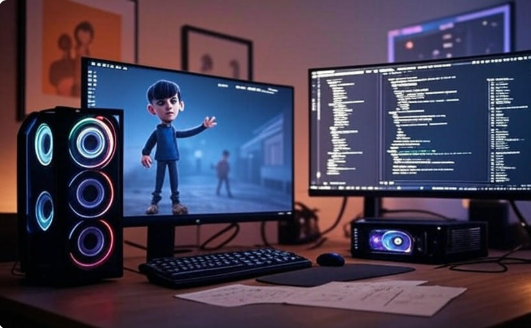Source Filmmaker (SFM) is a powerful tool for creating animated films using assets from the Source engine. Whether you’re a hobbyist or a professional, learning how to properly compile models, textures, and animations is essential to leveraging SFM’s full capabilities. The process, known as “sfm compile,” can seem intimidating at first, but with a structured approach, you can efficiently bring your custom assets into SFM and create high-quality content.
This comprehensive guide breaks down everything you need to know about the SFM compile process. From setting up your tools to fixing common errors, you’ll find actionable steps and expert tips to streamline your workflow. By the end, you’ll have a strong understanding of how to prepare, compile, and optimize your assets for use in Source Filmmaker.
What Does “SFM Compile” Mean?
Before diving into technical steps, it’s important to clarify what “sfm compile” involves. In the context of Source Filmmaker, compiling refers to converting your source files (models, textures, animations, maps) into a format that the Source engine and SFM can understand and use. This process typically includes:
- Compiling 3D models into .MDL files
- Converting texture images into .VTF and .VMT files
- Preparing and exporting animations in .SMD or .DMX formats
- Packaging everything properly so SFM can access it
This process ensures your assets load correctly and perform reliably within the Source Filmmaker environment. It also gives you control over how your models appear, behave, and interact with lighting and other elements in your scenes.
Tools Required for SFM Compile
Before beginning any compile process, it is crucial to have the right tools installed and configured. These are the essential utilities used in the SFM compile pipeline:
1. Crowbar
Crowbar is the most widely used GUI tool for compiling and decompiling Source engine models. It handles .QC scripts and works directly with the Source SDK tools.
2. Studiomdl
This is the core model compiler provided in the Source SDK. It’s a command-line tool but is usually accessed through Crowbar for convenience.
3. VTFEdit
Used for converting common image formats such as PNG, TGA, or JPG into .VTF files (Valve Texture Format). It also helps in creating .VMT material files.
4. Blender (with Source Tools) or 3ds Max
These 3D modeling and animation tools allow you to create, rig, skin, and animate your models. Source Tools for Blender enables direct export to .SMD or .DMX formats.
5. Notepad++ or any code editor
Used to write and modify .QC, .VMT, and game configuration files with proper syntax highlighting and search/replace capabilities.
6. GCFScape (optional)
Allows you to extract models and materials from Valve game content (e.g., Team Fortress 2 or Half-Life 2) for learning or reference.
Step-by-Step: Compiling a Model for SFM
Step 1: Create and Prepare Your Model
Create your model in Blender or 3ds Max. The mesh should be clean, with proper edge loops and UV unwrapping. Apply all transformations and name your mesh objects clearly. Attach materials even if they’re placeholders.
Step 2: Export the Model
Use Blender Source Tools to export the model as an .SMD file (or .DMX if preferred). Export a reference SMD and any other animation or physics SMDs as needed.
Step 3: Write the QC File
A .QC file is like a blueprint for the compiler. It tells the compiler how to build your model and where to find its parts.
Example:
$modelname "custom_items/my_model.mdl"
$body mybody "my_model_reference.smd"
$cdmaterials "models\custom_items"
$surfaceprop "metal"
$sequence idle "idle_anim.smd" loop
$collisionmodel "my_model_physics.smd" {
$mass 50
$concave
}Step 4: Compile with Crowbar
Open Crowbar, load your QC file, and hit “Compile.” Ensure you have selected the correct game directory (usually SFM’s “usermod”). Crowbar will show a log of the compilation process. If successful, your .MDL and associated files will appear in the destination directory.
Step 5: Test in SFM
Launch Source Filmmaker and attempt to load your model using the Animation Set Editor. If the model appears correctly and animates as expected, the compile was successful.
Textures must be in Valve’s .VTF format and paired with a .VMT material definition.
Step 1: Create and Export Texture
Design your texture in an image editing program and save it as a .TGA or .PNG file. Ensure it matches the UV map used on your model.
Step 2: Convert to VTF
Open VTFEdit, load the image file, and save it as a .VTF. Choose compression options suitable for your material type (DXT1 for opaque, DXT5 for transparency).
Step 3: Write a VMT File
A basic VMT file looks like this:
"VertexLitGeneric"
{
"$basetexture" "models/custom_items/my_texture"
"$surfaceprop" "metal"
}Place the .VMT file in the same directory as your .VTF.
Step 4: Install into SFM
Copy your .VTF and .VMT files into:
SourceFilmmaker\game\usermod\materials\models\custom_itemsCompiling Animations for SFM
Step 1: Animate in Your 3D Software
Rig your model with a skeleton and animate it in Blender or 3ds Max. Export animations in .SMD or .DMX formats using Source Tools.
Step 2: Include Animations in QC File
Extend your QC script to add sequences:
$sequence walk "walk_anim.smd" loop fps 30
$sequence run "run_anim.smd" loop fps 30Animations will appear as clips you can trigger in SFM.
Step 3: Recompile the Model
Use Crowbar again with your updated QC file to compile the model. SFM will recognize all the new sequences and apply them to your model.
Adding Collision Models
Models used in Source need collision data. This is typically a simplified mesh (e.g., low-poly capsule or box shape) exported as a separate .SMD.
In your QC file:
$collisionmodel "collision.smd" {
$mass 30
$concave
$inertia 1.0
}Compile the model again with Crowbar to include the collision information.
Organizing Files and Folders
Keep your project organized. Suggested structure:
/SFM_Projects/
/my_model/
/model_src/
my_model.blend
my_model_reference.smd
walk_anim.smd
/materials/
my_texture.tga
my_texture.vtf
my_texture.vmt
/compiled/
.mdl, .vtx, .phy, etc.This helps with future updates and troubleshooting.
Common Errors and How to Fix Them
Model not found in SFM
Ensure you compiled to the correct directory and that the model path in your QC file is accurate.
Texture not displaying
Check VMT path syntax and make sure the .VTF exists in the same relative directory.
Animation doesn’t appear
The sequence may not be properly defined in the QC file. Also, verify that the exported animation file isn’t corrupted.
Crowbar compilation fails
Review the error log. Typical causes include bad file paths, missing quotation marks, or syntax errors in the QC file.
Optimization Tips for SFM Compile
- Use LODs (Levels of Detail) for large models to improve performance
- Use efficient texture formats to reduce memory usage
- Reduce bone count if the model doesn’t need detailed deformation
- Remove unnecessary faces and vertices from unseen parts
- Combine similar materials and reuse textures when possible
Frequently Asked Questions
What is the difference between .SMD and .DMX?
.SMD is an older format compatible with most Source tools. .DMX supports more data and flexibility, especially for facial animations.
Can I use the same files in both SFM and Garry’s Mod?
Generally yes, but sometimes physics settings or folder structures need to be adjusted slightly.
Where can I find sample QC files?
QC files are often found in the “modelsrc” folders of game SDKs or community tutorials. You can also decompile existing models using Crowbar.
Do I need to compile every time I make a small change?
Yes, if you modify geometry or animations. For material tweaks, you can often reload textures without recompiling the model.
Conclusion
Mastering the SFM compile process is a crucial step toward creating polished, custom content in Source Filmmaker. By breaking it down into manageable steps—preparing models, compiling textures, exporting animations, and resolving errors—you can produce high-quality assets that behave reliably in SFM.
This guide provides a complete overview for beginners and intermediate users alike. With consistent practice and attention to detail, you’ll be able to compile models, materials, and animations efficiently and effectively.
Remember, the more you experiment and iterate, the smoother your workflow becomes. Whether you’re building characters, props, or entire scenes, understanding how to compile for SFM unlocks the full creative potential of the tool. Stay organized, document your process, and keep refining your assets—and the “sfm compile” process will soon become second nature.












